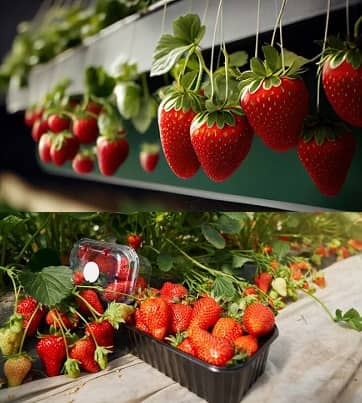If you’re looking for a creative and space-saving way to grow strawberries, pallet planters could be your solution. Handmade from a single wood pallet, these planters can fit a surprising number of strawberry plants, making them ideal for small spaces like patios or container gardens. But how exactly can you get started? Let’s dive into the steps, materials, and techniques for growing strawberries in pallets.
How to Grow Strawberries in Pallets
Materials You’ll Need
Before you start building your strawberry pallet planter, gather the following materials:
- Straw, burlap, or landscaping fabric for lining the planter.
- A mix of multi-purpose potting soil and garden compost (or composted manure).
- 12 strawberry plants.
- Scissors for trimming your fabric.
These basic materials are both inexpensive and easy to work with, making pallet planters a cost-effective way to grow your own strawberries.
Choosing the Best Strawberry Plants
What kind of strawberries should you plant? For the best and most consistent harvest, I recommend everbearing (day-neutral) strawberry plants. Varieties such as Mara des Bois, Eversweet, Fort Laramie, or All Season Fruiting are great options. These plants produce berries steadily throughout the growing season, rather than delivering all their fruit in one big harvest. Alternatively, you can choose Alpine strawberries, which offer smaller, wild-flavored berries that are fun to pick with kids but don’t create runners.
Finding the Perfect Spot for Your Planter
Once your pallet planter is ready, you’ll want to place it in the right location. Strawberries thrive in full sun, so aim for 8 to 10 hours of direct sunlight each day. Keep in mind, though, that once filled with soil, the planter becomes heavy. If you haven’t added wooden feet to your pallet, consider setting it on bricks to elevate it and avoid water damage to your deck or patio from runoff.
Lining the Pallet Planter
A critical step in preparing your pallet for planting is lining it. Without a liner, your potting mix will fall through the gaps between the slats. Although straw works as a liner, it tends to break down after a year, so I recommend using durable landscaping fabric. For an eco-friendly option, biodegradable cornstarch-based fabric is available and lasts 5 to 8 years before breaking down naturally.
Preparing the Potting Mix
Next, it’s time to fill your planter. The best mixture for strawberries combines moisture retention, good drainage, and plenty of nutrients. A 1:1 ratio of potting mix and garden compost or composted manure works wonders. You can also add slow-release organic fertilizer and vermiculite to the mix for better moisture retention and nutrient delivery. Vermiculite helps create air pockets in the soil, ensuring roots get plenty of oxygen.
Planting Your Strawberries
One of the best things about pallet planters is that you can plant on both the top and sides of the pallet. To plant in the slats, cut slits in the lining material and carefully insert your strawberry plants from the inside of the pallet. Space the plants about 15 inches apart on the top of the pallet, and consider adding a layer of mulch to the surface. Mulch helps retain moisture and prevent weeds from growing, making it an essential part of your planting process.
Fertilizing for Ongoing Growth
Over time, nutrients in the soil will deplete, especially in container gardens. Start by mixing slow-release fertilizer into the soil at planting. Later, during mid-summer, switch to a diluted liquid plant feed once a week to keep your strawberries healthy and productive. You don’t need to purchase expensive plant food—homemade options made from nettles, comfrey, or seaweed work just as well.
Watering Your Planter
Keeping the soil moist—but not waterlogged—is key to successful strawberry growth. Over-watering can wash away nutrients and cause root rot, while too little water will dry out the plants. Consider adding ollas, low-tech water reservoirs, to help maintain consistent moisture levels. These are particularly useful during hot or windy weather when containers tend to dry out more quickly.
Winter Care for Strawberries
Strawberries are perennial plants, meaning they come back year after year. However, during winter months, temperatures below 20°F (-6.6°C) can harm the plants. In areas with harsh winters, covering your plants with straw mulch helps insulate them. If possible, move the pallet planter to a sheltered spot, such as against your house or inside an unheated greenhouse or garage, to protect the roots from freezing. Just be sure the soil doesn’t dry out completely.
Planter Longevity and Replanting
How long will your pallet planter last? It depends on your local climate and pest conditions. On average, a well-maintained planter can last 5 to 6 years. Strawberry plants themselves produce well for about 3 to 4 years, after which you may need to replant to continue getting robust harvests. Simply follow the same steps for planting, and your pallet will continue to provide bountiful berries for many years to come.
How Long does it Take for Strawberries to Grow
Strawberries typically take about 4 to 6 weeks to grow from the time the flowers are pollinated until the berries are ready to harvest. After planting strawberry seedlings or runners, you can expect fruit in the first season if they are everbearing or day-neutral varieties, usually within 2 to 3 months. For June-bearing strawberries, fruit production usually occurs the following year after planting.
The growing time can vary depending on factors like the strawberry variety, climate, and growing conditions.
How to Care for Strawberry Plants
When it comes to nurturing strawberry plants, proper care is key to getting sweet, abundant harvests. Let’s break down the essentials.
Planting Time
Choosing the right time to plant your strawberries is crucial. Ideally, plant them in mid-spring or late summer, and make sure to complete the process by early September, depending on where you live. In colder regions, finishing the planting before the first week of September is recommended, while warmer areas can push this to the second week. Planting in August or early September allows your strawberry plants more time to settle, leading to better fruit production.
Soil Requirements
Strawberries love fertile, well-drained, and slightly acidic soil. If you’re dealing with poor or heavy soil, raised beds are a better option as they improve drainage and give the roots more space to grow. Imagine the difference between planting in compact soil versus one with a soft, rich mix where the roots can breathe easily. Strawberries need the right environment to flourish, and healthy soil is a big part of that.
Sunlight Needs
Strawberry plants thrive in full sun, basking in 6 to 10 hours of light, which helps them produce the sweetest, juiciest fruits. However, they aren’t completely picky—they can tolerate some shade, particularly Alpine strawberries, which perform well in lightly shaded areas. Picture rows of bright, red berries soaking up the sunshine on a warm day, growing lusciously with every passing week. That’s the magic of placing them in an ideal sunny spot.
Frost Protection
One of the biggest threats to strawberry plants is late frosts. These unexpected cold snaps can damage the flowers, leading to an issue called “strawberry black eye,” where the center of the blossom turns dark, preventing fruit from forming. To avoid this, it’s essential to plant your strawberries in a location that’s not prone to frost, such as sheltered areas or spaces with natural wind barriers.
Disease Prevention
Lastly, keeping diseases at bay is vital for healthy strawberry growth. One common issue is verticillium wilt, a soil-borne fungus that can wipe out entire crops. To reduce the risk, avoid planting strawberries in areas where potatoes, chrysanthemums, or tomatoes were previously grown. By rotating your crops and being mindful of where you plant, you can protect your strawberries from harmful diseases.


